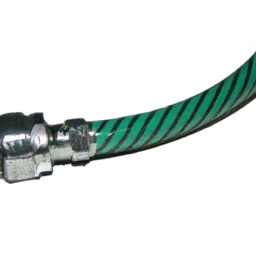Garden Hose Fitting What Is The Size
Table of Contents []
What Is The Size Of A Garden Hose Fitting
Introduction
Garden hoses and their fittings are essential components of a great outdoor area, but one of the most critical questions for any homeowner is, what is the size of a garden hose fitting? This article is your guide to learning the correct dimensions and measurements necessary to buy a perfect garden hose fitting and understand its components. First, we'll look at the basics, then discuss the range of sizes available to complete the job, and ultimately look at how to use a garden hose fitting properly.
Hose Size Types
The hose size describes the size of a garden hose fitting and its attached hose. It's typically denoted on the surface of the fitting in a numerical form such as 1/2 inch, 5/8 inch, or 3/4 inch. The numerical form states the outer diameter, or O.D., of the garden hose fitting. There are four common sizes for garden fittings; 1/2 inch, 5/8 inch, 3/4 inch, and 1 inch.
1/2 Inch
The 1/2 inch fitting is the most common size and is ideal for most outdoor uses. It has a diameter of 0.5 inches and typically matches up with a 1/2 inch hose. This fitting connects nicely to a variety of outdoor appliances, including lawnmowers, pressure washers, and power tools.
5/8 Inch
The 5/8 inch fitting is slightly larger than the 1/2 inch fitting and, as the name suggests, has a diameter of 0.625 inches. It's better suited for more robust applications, such as connecting a garden hose to a powerful pressure washer or a outdoor spigot that provides higher water pressure.
3/4 Inch
The 3/4 inch fitting is larger than the 5/8 inch fitting and is designed for larger applications, such as connecting a garden hose to a garage sink or an outdoor shower. It has a diameter of 0.75 inches and is a good way to move larger volumes of water with ease.
1 Inch
The 1 inch fitting is the largest of all the garden hose fittings and is designed for large-scale applications, such as connecting a garden hose to a pool pump. It has a diameter of 1-inch and is typically used to move large volumes of water quickly.
Use and Installation
It's important to note that the wrong size garden hose fitting can cause leaks, and connecting a garden hose fitting of too large a size to an appliance can cause the appliance to become damaged due to the increased amount of water pressure. Make sure to buy the correct size hose fitting for the Connect other garden hose fittings, such as adapters or couplers that will connect two or more to the same appliance. Once you're sure you've selected the correct size, it's time to install.
Flexible Tubes
Modern garden hoses are usually made of flexible tubes that are designed to fit snugly around the garden hose fitting. This makes the job of connecting a garden hose to the fitting simple and quick, as the flexible tube slides easily into the fitting. Pay attention to the length of the flexible tube, as it needs to be long enough to fit in the right position to secure a complete connection.
Tightening
Once you've connected the garden hose fitting, it's time to tighten the connection. This is done by unscrewing the knurled nut on the outside of the fitting. Be sure to do this slowly and carefully, as over-tightening can damage the threads of the fitting and cause leaks. Once the nut is tight, the connection should be completely secure.
Summary
Garden hoses and fittings are an essential part of a great outdoor space. When buying a garden hose fitting, it's important to understand that the size of the fitting is determined by the outer diameter (O.D.) of the fitting. Common sizes include 1/2 inch, 5/8 inch, 3/4 inch, and 1 inch. When connecting a garden hose fitting, pay attention to the length of the flexible tube, as it needs to be long enough to fit in the right position for a secure connection. Once the connection has been made, slowly and carefully tighten the knurled nut on the outside of the fitting to ensure a secure connection. Following the tips above will help ensure that your garden hose fitting is installed correctly and safely.

Previous Page
